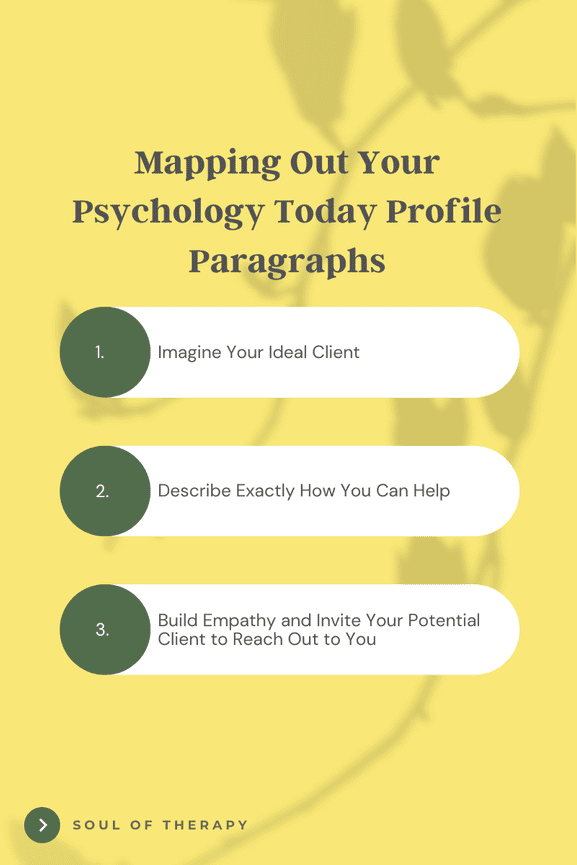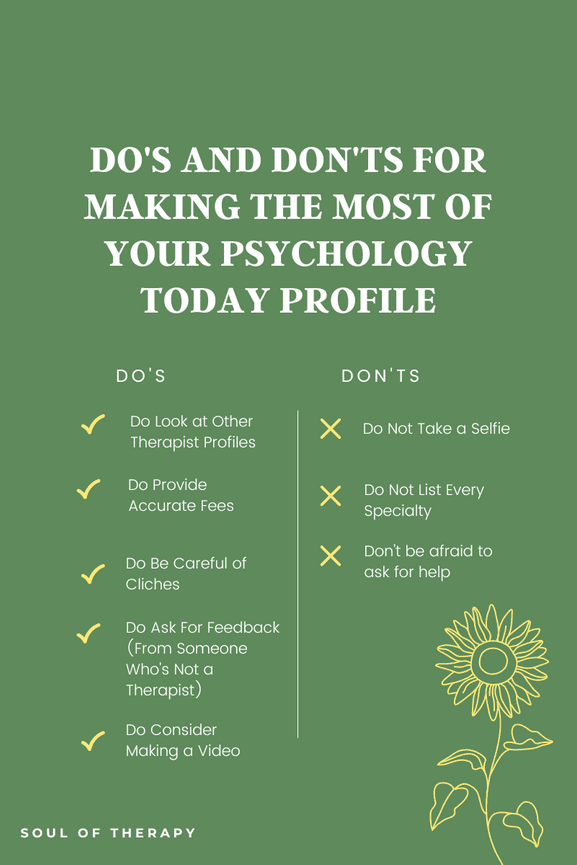How the f**k do I write my therapist profile? If I'm just starting out, how do I speak directly to an ideal client (if I don't even know who that client is?) How do I make sure I'm not just spewing clinical jargon or throwing out false promises?
If you've asked yourself these questions, you're in good company. I hear them all the time from my writing clients. To date, writing Psychology Today personal statements remains my most-requested therapist service! I have edited and written over 1000 of these therapist bios, so I feel pretty confident in knowing what works best.

Should You Make a Psychology Today Profile?
First of all, is it worth paying for a Psychology Today membership? Usually, yes. But let's explore some of the pros and cons.
Advantages of Psychology Today
Top search engine for potential clients: Think like a prospective client and not a therapist. This is where most clients first search when they're looking for a new therapist. Psychology Today dominates the top spots of Google due to its paid and organic listings.
Credibility: Regardless of your personal opinion, Psychology Today generally has a positive reputation among clients.
High ROI: A Psychology Today profile costs $30/month. If you charge $100 a session, one lead earns you money after just that first session.
Diversification is always recommended: I always recommend our clients expose themselves on several platforms, especially when they're first starting in the field. You want to come up in numerous online searches- that increases the chances of the right clients finding you.
Free six-month trial: Psychology Today regularly runs free six-month promotions for new members. If you're just establishing your business (or want to see how being on a directory works for you), there's little downside to accepting this trial.
Disadvantages of Psychology Today
Psychology Today isn't a perfect platform, and it may not be the right choice for your private practice. Over the years, the company has received its fair share of complaints.
Some concerns:
No credible SEO backlink: Even though you can share your own website button on Psychology Today, it's not an actual dofollow link (meaning you don't get the SEO link juice that you might on another site. Instead, when someone clicks on your website button, they're momentarily sent to another site before yours.
Lack of diversity within their magazine: The print magazine, Psychology Today, has come under fire for prominently and persistently featuring white, thin women. This article explains it well.
May have difficulty standing out: If you're in a very saturated area, your profile may not look that distinguished from the dozens of other therapist profiles competing for potential clients (and that's why writing a killer bio is so important!).
Tax concerns(?): Psychology Today is owned by Sussex Directories, a company that's located in the Cayman Islands. One of the clearest benefits of establishing a business in the Cayman Islands is that there is no direct taxation. Businesses do not have to pay either personal income or corporate taxes- and they also get to enjoy tax-free gains on their profits. Take this information as you see fit.

Getting Started With Your Psychology Today Profile
1360 characters. That's exactly what you're allocated on Psychology Today to describe your private practice and attract dream clients. That's not a lot of words, and many people don't quite know what to do with those three short paragraphs.
If you want a stand-out profile that speaks directly to your intended audience, here's what I recommend you do:

First Paragraph: Imagine Your Ideal Client
Notice I didn't say clients. In this exercise, the client is singular, and I encourage you to focus on just one person for the sake of this practice.
Now answer the following questions:
What issue is bringing them to therapy?
What have they (likely) tried in the past?
What fears might they have about therapy?
What does this client MOST want from therapy?
I also recommend giving your client a name. Names create a story, and your therapist bio tells a story. When you tell a story, you're not just writing to potential clients 'struggling with anxiety.'
You're writing to Melanie, a 34-year-old mother of three who feels out-of-control managing work, family, and her marriage. She's tried some therapy in the past but hasn't been consistent with it. Mostly, she wants to find a sense of balance. She doesn't know what balance looks like (and who does?), but she believes that therapy can help her improve her confidence and feel better as a mother, wife, and employee.
Knowing Melanie's backstory takes us from, Do you struggle with anxiety? Do you want more balance in your life? Do you feel overwhelmed by your family, work, and other obligations? to this:
On the surface, things are going well, but you've felt anxious for a long time. Kids, marriage, work- the responsibilities just keep piling up, and you're downright overwhelmed. You know that finding balance is important, but you often wonder what that even means. Your tendencies to people-please make it difficult to prioritize your own needs. At the same time, you realize something has to change.
When you tell a story, you're not just writing to 'children and adolescents.'
You're writing to Jake and Laura, a married couple in their forties with a teenage boy, Adam. They're worried about Adam's change in mood and peer group. They're concerned he might be using drugs. They've tried talking to their son, but they feel shut down. They've spoken to the school counselor, but haven't made much progress. They want Adam to talk to someone who understands teenagers and can help their son feel supported.
Knowing Jake and Laura's backstory takes us from, I work with children and adolescents with a variety of mental health issues to this:
There's nothing quite like parenting a teenager. At times, it feels like you're in a constant battle. Their mental health worries you, but you fear you're saying or doing the wrong thing. You want to support your child, but you keep feeling shut out. Nothing seems to be working, and you're starting to feel desperate.
What If You Don't Know Your Ideal Client??
Spend some time really honing in on your ideal client. Who are they? Why are they seeking therapy at this time? What brings them pain? What gives them hope?
If these questions feel too broad, it's because they are! But it's also because honing down a specific client requires time, expertise, and some trial and error.
The goal here is to develop some semblance of a therapy niche. You don't need to achieve this goal overnight, and it isn't a bad thing if you're struggling with this concept. But most people in private practice find success by cinching down rather than broadening out.
Second Paragraph: Describe Exactly How You Can Help
This is your precious space to talk about what you bring to the therapy table. Most people get stuck in this section, so let's talk about what not to do first.
Don't Just Spew Out Theory
That's great that you offer CBT and DBT. But most clients won't understand what those terms mean (unless your ideal clients are therapists). Instead, it's better to keep this section focused on what those theories actually mean.
You could say, I specialize in EMDR. Or, you could say, I use EMDR to help clients heal from the traumatic events holding them back.
Don't Talk Excessively About Your Education
With an undergraduate psychology degree from NYU and a graduate degree from Princeton...
That's a waste of precious real estate! Whether you realize it or not, most prospective clients don't find a therapist based on their education or preferred interventions. They find a therapist based on how that therapist makes them feel.
Don't Be Too Generic
I am here to help you move forward.
I believe all people are unique.
I am passionate about what I do.
What do these statements have in common? They're vague and limited. They also don't really say anything about your process. If the words feel fluffy, delete them. Try something else. The idea is that your writing is concise and can address exactly what you provide.
Do Be Specific and Speak Directly to Your Dream Client
Do you see me? Will you understand me? Are you there for me?
That's what a desperate client wants to know. So, in this paragraph, you're going to focus on answering YES to those three questions.
Here are some great examples:
Having spent the past decade working with families, my main priority is to help you help your child. Together, we will work on improving communication, strengthening boundaries, and building a healthy parent-child relationship. This work can be hard, but I am here to support and encourage you throughout the process.
I specialize in working with young adults with eating disorders. Eating disorders can be complex, insidious conditions, and it's normal to feel hesitant to start treatment. My approach balances genuine compassion with structured support toward growth. I believe in a full recovery, and I strive to help my clients reach that wonderful place.
Therapy for anxiety can be challenging, but my person-centered approach focuses on helping clients accept themselves- while also changing how they respond to stress. With a specialty in panic disorder, I will support you in recognizing your triggers, practicing healthier coping skills, and feeling more empowered in your life.
Third Paragraph: Build Empathy and Invite Your Potential Client to Reach Out to You
Here's the deal: This is your close, and it's just as important as your intro.
If a client is interested in you, they're going to read every word of your profile (and they may read it several times). In my experience, many therapists overlook the importance of the details of this section.
Don't make this mistake- you want to keep potential clients focused and intrigued by what amazing services you offer!
Here is an example of a great closing paragraph:
The decision to enter therapy can be a challenging one, especially if you've spoken to professionals before and left disappointed. Today, I invite you to reach out for something different. I want to offer you the valuable opportunity to look within yourself and access the strength and tools that will propel your life. Let's connect.
Here is another example:
You're tired of feeling tired. And if you've read my profile up until this point, there might be something in my words that resonate with you. You know you deserve something different. You know there's more to life than mere survival. If you're ready for something new, please contact me for a free 15-minute consultation.
Other Do's and Don'ts for Making the Most of Your Psychology Today Profile
I'd like to address a few mistakes I often see therapists make in their Psychology Today profiles. Of course, this is your space, and what works well for one therapist may not yield the same results as someone else.
That said, I do this professionally, so I'd like to pass on some tips to help you better advertise your awesome work!

Do Look at Other Therapist Profiles
Here's a fun exercise: pretend you're looking for a new therapist for yourself.
Now browse through some of the profiles in your local area. Which ones jump out and intrigue you? Which ones seem downright unprofessional? Do you notice any specific details or trends? What does the best therapist profile have?
Here's another fun exercise: look at your competitors' profiles.
How are they talking to your dream client? Do they speak directly to them? Do they seem to have an innate understanding of their needs and pain points? Can they connect to their stress and bring forth a sense of solution?
Do Not Take a Selfie
Something, something, a picture is worth a thousand words!
I recommend professional headshots, but I understand that there are a lot of expenses when you first start a private practice. If money is tight, at least have a qualified friend take a clear photo. And if you're not sure which one looks best, get a few opinions.
Do Provide Accurate Fees
Your dream client needs to know how much your services cost.
If you raise your rates, adjust them on your profile accordingly. Otherwise, you will be fielding numerous inquiries from clients wanting you to honor your listed rate (and who can blame them?)
Do Not List Every Specialty
Don't have that obnoxious Psychology Today profile that lists treating everything from A-Z.
You do not specialize in everything, and this is such a deceptive practice!
Do Be Careful of Cliches
I don't have a thing against cliches. They serve a purpose. Most of the time, they wouldn't be as popular as they are if they didn't hold some grain of truth to them. And yet, you want you and your business to stand out.
Do Follow-Up!
Reaching out for help is such a vulnerable thing to do.
As much as possible, try to respond to the inquiries you receive from Psychology Today. If your practice is full, then you should indicate that.
Do Ask For Feedback (From Someone Who's Not a Therapist)
Therapists are biased (and we often focus on the wrong things when it comes to how we advertise). So ask a friend or family member to skim through your profile. Do they find it intriguing? Would they have a reason to call or write to you?
Do Consider Making a Video
You can upload a video on your Psychology Today profile, and while I haven't dug into the research on whether or not it's an effective form of advertising, I'll leave you this takeaway: If done professionally and concisely, it definitely won't hurt.
There's a reason clients turn to social media platforms to learn about therapy and connect with mental health professionals.
Why You Should Update Your Profile Regularly
Although it isn't officially confirmed, there are numerous rumors indicating that Psychology Today favors therapists who recently update their profiles. They rise their profiles to the top of a specific search result.
Is this true? I can't say for sure. But it doesn't hurt to periodically make a small update once a month or so.
Final Thoughts On Crushing Your Psychology Today Profile
It isn't easy to write a therapist profile or advertise your practice!
Most therapists downplay the importance of reaching their exact audience. But if you want your business to grow, you need to know how to market your services.
Your dream clients want to find the right therapist, and you want to ensure you're writing your bio in a way that speaks to them directly.
At Soul of Therapy, I help therapists fine-tune their Psychology Today profiles, and I provide flat-rate pricing from start to finish. I have written 1500+ profiles for mental health professionals like you!
I am confident I can help craft an accurate and inviting profile that converts. Contact me today to learn more!


0 Comments